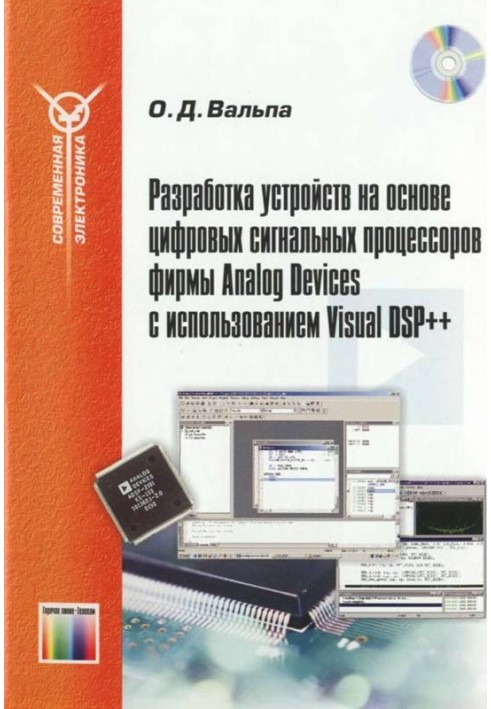Development of devices based on digital signal processors from Analog Devices using Visual DSP++
 Instant download
Instant download
after payment (24/7)
 Wide range of formats
Wide range of formats
(for all gadgets)
 Full book
Full book
(including for Apple and Android)
The book is intended for independent study and practical application of digital signal processors DSP (Digital Signal Processor). Using the popular ADSP2181 microcircuit from Analog Devices as an example, the design, architecture and technical characteristics of a digital signal processor are considered. A description of the processor's computational units, software development tools, programming language and processor command system is provided. The practical diagrams developed by the author of the book using a signal processor, source codes of programs and diagrams of auxiliary devices useful in debugging programs for the processor will help to obtain the necessary practical skills with which the reader can easily master other types of signal processors. On the disc included with the book contains the source texts and executable files of the programs, as well as some useful utilities and software development tools for signal processors. For specialists in the field of development of digital electronic equipment, it will be useful for students and graduate students.
This part of the book covers history of the development of various signal processors and provides an overview of the technical characteristics of the ADSP-21XX family of signal processors. In addition, it provides a practical diagram of the use of the ADSP-2181 processor, describes its architecture and program logic model, and describes the processor interrupt system.
Digital signal processors, or DSPs for short, have now become very popular. digital signal processor). This book will lift the veil the mystery of these components and will allow readers to independently master them and use them in their own designs.
This chapter describes the internal architecture of one of the Analog Devices ADSP-2181 signal processors and examples of its connection.
This chapter provides example circuit diagrams using the ADSP-2181 signal processor, showing how it can be wired for use in various designs.
This chapter describes the processor's interrupt system, which allows the processor to quickly respond to various events.< /p>
This part of the book describes the creation of the first working program for the signal processor and its translation to obtain executable code. A description is given of the boot procedure and the ports through which this operation is possible. A description is given of a device developed by the author for downloading programs, viewing and editing processor memory using a computer. The purpose and operation of a special memory manager program is described. Provides a description of the assembler directives, data format, and instruction set for the signal processor.
This chapter covers creating signal processor programs, instrumentation software, debugging, and how to load programs into the signal processor.
< p>This chapter describes the processor's byte direct memory access port, called BDMA (Byte Data Memory Access).This chapter describes the IDMA interface port and how to load and debug signal processor programs through this port .
Now that you've become familiar with the IDMA port, you can begin to look at a device that allows you to load programs and edit signal processor memory data through the IDMA interface port.
This chapter describes a program called "Memory Manager", developed by the author of the book for loading programs into the signal processor and debugging them.
This chapter talks about directives that are used to control the process of assembling programs.
This chapter talks about data representation formats in the signal processor when performing computational operations.
This chapter begins the presentation of the command system of the signal processor.
This part of the book talks about the computing and hardware devices of the signal processor, to which These include an ALU, a MAC multiplier, a shifter, a bus communication unit, a program machine, address generators, a timer, and synchronous serial ports. The architecture of these devices and the commands they execute are described.
This chapter describes the signal processor's MAC (multiplier accumulator) computing device and the commands it executes.
In this chapter talks about the signal processor shifter and the commands it executes.
This chapter talks about the communication between the PMD program memory and DMD data buses.
This chapter talks about the software signal processor machine and the commands executed with its help.
This chapter talks about address generator devices of the signal processor and the commands executed with its help.
This chapter talks about the structure of the signal processor timer and its purpose.
This chapter talks about the two synchronous serial ports included into the signal processor, about their design, purpose and use.
This part of the book talks about installing a modern software development tool for signal processors on a computer - the Visual DSP++ software package, its launch and operation. Examples of programs and their debugging in the development environment are provided. Spectral analysis of a signal using Visual DSP++ is demonstrated. This chapter talks about programming in C in this development environment.
This chapter talks about installing a modern development tools for signal processors - the Visual DSP++ software package.
This chapter describes the use of a modern software development tool for signal processors - the VisualDSP++ software package.
This chapter discusses further examples programs, ways to configure the simulator and obtain a boot file in the VisualDSP++ development environment.
This chapter discusses the software method for spectral analysis of a digital signal using the example of a program executed in the Visual DSP++ development environment.
This the final chapter of the book, which examines examples of programs in the C programming language and their execution in the Visual DSP++ development environment.
Data sheet
- Name of the Author
- Олег Вальпа Дмитриевич
- Language
- Russian












